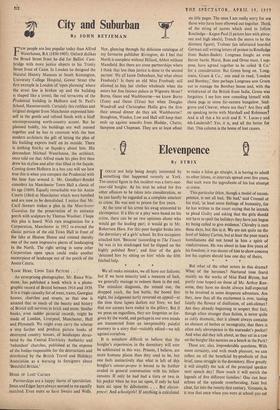City and Suburban
By JOHN BETJEMAN FEW people are less popular today than Alfred Waterhouse, RA (1830-1905). Oxford dislikes the Broad Street front he did for Balliol. Cam- 3ridge with more justice objects to his Trinity Street front of Caius. In London he designed the Natural History. Museum at South Kensington, University College Hospital, Gower Street (the first example in London of 'open planning' where 'the street line is broken up and the building is shaped' like a Cross), the red terracotta of the .0rudential building in Holborn and St. Paul's School, Hammersmith. Certainly this ruthless and Original designer from Manchester expressed him- self in the gentle and refined South with a bluff uncompromising north-country accent. But he planned boldly, his buildings are well massed together and he has in common with the best modern architects the gift of letting the plan of his building express itself on its outside. There is nothing finicky or facade-y about him. His descendant Michael Waterhouse, the architect, once told me that Alfred made his plan first then drew his skyline and after that filled in the facade. Coming down Holborn in a bus you will see how true this is when you compare the Prudential with the later fuss around it. Mr. Goodhart-Rendel considers his Manchester Town Hall a classic of its age (1869). Equally remarkable was his Assize Courts (1864) at Manchester which were bombed and are now to be demolished. I notice that Mr. Cecil Stewart makes a plea in the Manchester Guardian for the preservation of its entrance porch with sculpture by Thomas Woolner. I hope this plea is heard. With rare imagination for a Corporation, Manchester in 1912 re-erected the lassic portico of the old Town Hall in front of the lake at Heaton House and created thereby One of the most impressive pieces of landscaping in the North. The right setting in some other Corporation open space could make another masterpiece of landscape out of the porch of the Assize Courts.
'LOOK HERE, UPON THIS PICTURE . .
An enterprising photographer, Mr. Reece Win- stone, has published a book which is a photo- graphic record of Bristol between 1914 and 1939. It is a tragic casualty list of trees, trams, Georgian houses, churches and streets, so that one is amazed that so much of the beauty and history of Bristol still survives in brick and stone. Similar books, even sadder pictorial records, might be made of London, Liverpool, Manchester, Hull and. Plymouth. We might even carry the scheme a step farther and produce picture books of destroyed country houses, of landscapes devas- tated by the Central Electricity Authority and 'redundant' churches, published at the expense of the bodies responsible for the destructions and distributed by the British Travel and Holidays 'Association as a warning to foreigners about 'Beautiful Britain.'
HOME OF LOST CAUSES Partnerships are a happy theme of speculation. Swan and Edgar have always seemed to me equally matched. Even more so have Swears and Wells. Nor, glancing through the delicious catalogue of my favourite publisher Rivington, do I feel that North is complete without Hillard, Abbot without Mansfield. But there are some partnerships where I think that less than justice is done to the second partner. We all know Debenham, but what about Freebody? Is there an old Miss Freebody still allowed to buy her clothes wholesale when she enters her fine faience palace in Wigmore Street? Burns, Oates and Washbourne—we know Burns (Tom) and Oates (Titus) but when Douglas Woodruff and Christopher Hollis give the firm their annual dinner do they ask Washbourne? Stoughton, Windus, Low and Hall still keep their ends up against assaults from Hodder, Chatto, Sampson and Chapman. They are at least afloat on title pages. The ones I am really sorry for are those who have been elbowed out together. Think of the string of names which used to follow Routledge—Kegan Paul (I picture him with pince- nez and high ideals), Trench (he seems to be the dimmest figure), Trubner (an infuriated bearded German still writing letters of protest to Routledge from Baden-Baden). Longman fought an even fiercer battle. Hurst, Rees and Orme must, I sup- pose, have agreed together to be called '& Co.' for a consideration. But Green hung on. 'Long- mans, Green & Co.,' one used to read, 'London and Bombay,' then perhaps Longman sent Green out to manage the Bombay house and, with the withdrawal of the British from India, Green was forgotten. I see him now consoling himself with chota pegs in some far-eastern bungalow. Snel7 grove and Cleaver, where are they? Are they still on speaking terms with Marshall and Robinson? And is all this a bit arch and E. V. Lucas-y and 4th-Leaderish? Yes, it is, and all the better for that. This column is the home of lost causes.


































 Previous page
Previous page